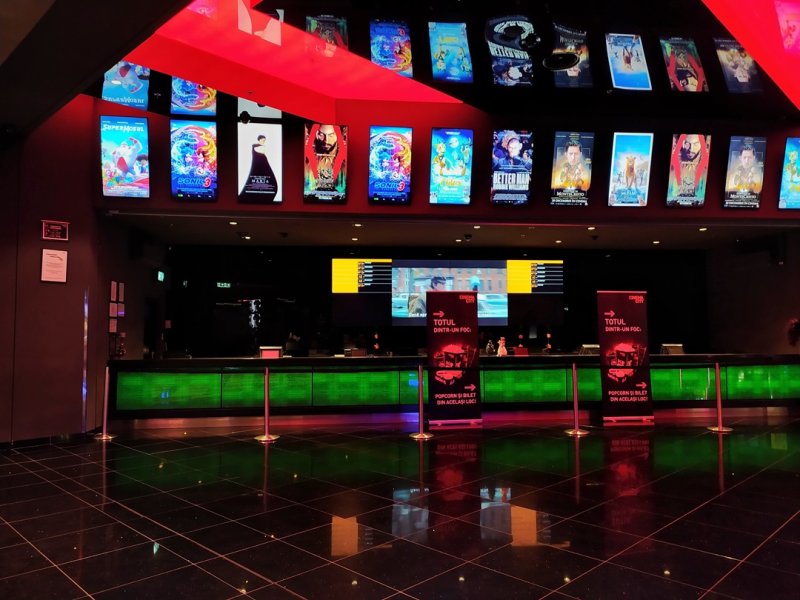Cinemas in Bucharest: between spectacle, refuge and a form of cultural resistance.

By Bucharest Team
- Articles
In an era when streaming platforms have turned living rooms into screening rooms, the cinema remains—paradoxically—a space of shared reconnection. It's no longer just about the films—it’s about the way we sit together in the dark, the simultaneous silences, the synchronized laughter, the unpredictable reactions of a room that breathes in unison. And Bucharest, with all its contradictions, offers a diverse cinematic map where European refinement, commercial comfort, and urban experimentation meet.
Elvire Popesco – where film speaks with a French accent
Run by the French Institute, Elvire Popesco is not just an arthouse cinema—it’s a place where a taste for film is cultivated. With an intimate screening room, 35 mm and digital DCP projection, and a carefully curated program that brings in European directors, festival gems, and rare documentaries, Elvire is the kind of place you don’t visit to see “what’s playing,” but to see what’s happening in the world—through someone else’s eyes. Screenings are often followed by discussions, cine-concerts, or educational events—a sign that here, a film doesn’t end with the credits, but starts a conversation. The atmosphere is calm, the audience engaged, and the feeling is that you're participating, not just consuming.
Cinema at the Museum of the Romanian Peasant (MTR) – a small hall for big ideas
Tucked in the museum's basement, this cinema is a cultural haven for those looking for more than just entertainment. Screenings are thoughtfully curated in partnership with the Europa Cinemas network and include titles with strong social, aesthetic, or identity-driven themes. The setting is relaxed, at times familiar, with post-screening discussions that turn viewing into dialogue and reflection. In summer, the museum’s courtyard becomes an open-air cinema, offering a poetic experience where film blends with the evening air and the slow rhythm of old Bucharest. MTR doesn’t sell popcorn—it offers quality time, critical thinking, and a sense of belonging.
ARCUB – an independent cinema with an urban soul
Inside a discreet building in the Old Town, ARCUB manages to offer a true alternative to the mainstream. There are no giant screens or plush seats, but something rarer: the atmosphere of an artistic lab, where films are often introduced by directors, actors, or critics, and the audience becomes part of the process. Independent films, shorts, documentaries, and experimental productions are shown—frequently followed by debates or live interventions. Here, cinema is treated as a form of cultural resistance and genuine interaction, not a mass product.
Cinemateca Union – where the classics never age
Union is a living chronicle of film history. Screenings are organized in thematic series—ranging from celebrated directors to cinematic movements—and include rare films, archive gems, and tributes to Romanian cinema. The atmosphere is both solemn and warm: the audience is mostly made up of passionate viewers who come to revisit or rediscover—not by chance, but with intent. This is not a place for spectacle or snacks—it’s a place to learn, feel, and travel to other cinematic eras. A space of visual memory that refuses to be forgotten.
Cinema City AFI Cotroceni & Mega Mall – commercial cinema at full volume
If there is a peak of commercial cinematic experience, it’s represented by the Cinema City multiplexes in AFI Cotroceni and Mega Mall. Technology takes center stage: IMAX halls with enormous screens and high-fidelity sound, 4DX with physical effects (motion, water, wind, light), and VIP lounges with reclining seats and premium menus. Audiences don’t come just for the film, but for the complete entertainment package. It’s not a place for reflection, but for full sensory immersion. The line-up includes the latest releases—from Marvel blockbusters to family animations. Accessible, predictable, and always buzzing, this is the kind of cinema that doesn’t ask questions—it offers quick and spectacular answers.
Hollywood Multiplex (Bucharest Mall – Vitan) – the multiplex pioneer
Opened in 2002, Hollywood Multiplex was the first cinema of its kind in Romania. Though newer, more tech-laden rivals have since appeared, it remains a solid option for moviegoers in the southern and eastern areas of the city. It features 10 screening halls, 4K projection, RealD 3D, a solid audio system, and a full program with multiple screenings per day. It’s a familiar, efficient, and comfortable place—where you know exactly what to expect. Without artistic pretensions but with a reliable infrastructure, it’s a neighborhood cinema in a modern format.
Grand Cinema & More (Băneasa Shopping City) – premium tech meets cultural ambition
Arguably the most technologically ambitious cinema in the city, Grand Cinema & More bets on spectacle but also cultural versatility. With 13 screening halls and over 2,600 seats, it includes the Grand Ultra hall—equipped with RGB 4K laser projection, Dolby Atmos with 52 speakers, and Guitammer vibrating seats that sync with the film’s low frequencies. The massive screen (22.5 by 13 meters) turns the viewing experience into something almost physical. But Grand is more than just blockbusters—it also hosts theatre-on-film shows, live opera transmissions, and satellite concerts. It’s less of a mall cinema and more of a multimedia cultural hub. Its audience is made up of demanding spectators who expect both comfort and meaningful content.
Bucharest offers a rich cinematic landscape, not just in terms of technical variety, but in the emotional tone each theater brings. From the nearly elitist refinement of Elvire Popesco to the sensory opulence of Băneasa, from the community-driven spirit of MTR to the streamlined entertainment of Mega Mall, the capital manages to hold together all forms of moviegoing. Cinema in this city isn’t dying. It’s reinventing itself—sometimes quietly, sometimes boldly—and it continues to do what it always has: gather us in the dark to watch the same stories, and feel them each in our own way.






























